Introduction
Most users at one time or another have
dealt with hierarchical data in a SQL database and no
doubt learned that the management of hierarchical data
is not what a relational database is intended for. The
tables of a relational database are not hierarchical
(like XML), but are simply a flat list. Hierarchical
data has a parent-child relationship that is not naturally
represented in a relational database table.
For our purposes, hierarchical data
is a collection of data where each item has a single
parent and zero or more children (with the exception
of the root item, which has no parent). Hierarchical
data can be found in a variety of database applications,
including forum and mailing list threads, business organization
charts, content management categories, and product categories.
For our purposes we will use the following product category
hierarchy from an fictional electronics store:
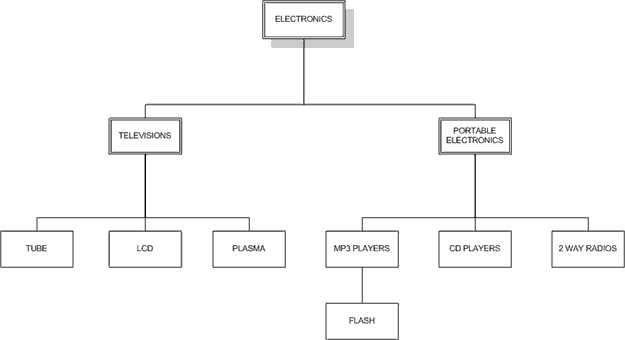
These categories form a hierarchy in
much the same way as the other examples cited above.
In this article we will examine two models for dealing
with hierarchical data in MySQL, starting with the traditional
adjacency list model.
The Adjacency List Model
Typically the example categories shown
above will be stored in a table like the following (I'm
including full CREATE and INSERT statements so you can
follow along):
CREATE TABLE category(
category_id INT AUTO_INCREMENT PRIMARY
KEY,
name VARCHAR(20) NOT NULL,
parent INT DEFAULT NULL);
INSERT INTO category
VALUES(1,'ELECTRONICS',NULL),(2,'TELEVISIONS',1),(3,'TUBE',2),
(4,'LCD',2),(5,'PLASMA',2),(6,'PORTABLE
ELECTRONICS',1),
(7,'MP3 PLAYERS',6),(8,'FLASH',7),
(9,'CD PLAYERS',6),(10,'2 WAY RADIOS',6);
SELECT * FROM category ORDER BY category_id;

10 rows in set (0.00 sec)
In the adjacency list model, each item
in the table contains a pointer to its parent. The topmost
element, in this case electronics, has a NULL value
for its parent. The adjacency list model has the advantage
of being quite simple, it is easy to see that FLASH
is a child of mp3 players, which is a child of portable
electronics, which is a child of electronics. While
the adjacency list model can be dealt with fairly easily
in client-side code, working with the model can be more
problematic in pure SQL.
Retrieving a Full Tree
The first common task when dealing with
hierarchical data is the display of the entire tree,
usually with some form of indentation. The most common
way of doing this is in pure SQL is through the use
of a self-join:
SELECT t1.name AS lev1, t2.name as lev2,
t3.name as lev3, t4.name as lev4
FROM category AS t1
LEFT JOIN category AS t2 ON t2.parent
= t1.category_id
LEFT JOIN category AS t3 ON t3.parent
= t2.category_id
LEFT JOIN category AS t4 ON t4.parent
= t3.category_id
WHERE t1.name = 'ELECTRONICS';

6 rows in set (0.00 sec)
Finding all the Leaf Nodes
We can find all the leaf nodes in our
tree (those with no children) by using a LEFT JOIN query:
SELECT t1.name FROM
category AS t1 LEFT JOIN category as
t2
ON t1.category_id = t2.parent
WHERE t2.category_id IS NULL;

Retrieving a Single Path
The self-join also allows us to see
the full path through our hierarchies:
SELECT t1.name AS lev1, t2.name as lev2, t3.name as
lev3, t4.name as lev4
FROM category AS t1
LEFT JOIN category AS t2 ON t2.parent = t1.category_id
LEFT JOIN category AS t3 ON t3.parent = t2.category_id
LEFT JOIN category AS t4 ON t4.parent = t3.category_id
WHERE t1.name = 'ELECTRONICS' AND t4.name = 'FLASH';

1 row in set (0.01 sec)
The main limitation of such an approach is that you
need one self-join for every level in the hierarchy,
and
performance will naturally degrade with each level
added as the joining grows in complexity.
Limitations of the Adjacency List Model
Working with the adjacency list model in pure SQL can
be difficult at best. Before being able to see the full
path of a category we have to know the level at which
it resides. In addition, special care must be taken
when deleting nodes because of the potential for orphaning
an entire sub-tree in the process (delete the portable
electronics category and all of its children are orphaned).
Some of these limitations can be addressed through the
use of client-side code or stored procedures. With a
procedural language we can start at the bottom of the
tree and iterate upwards to return the full tree or
a single path. We can also use procedural programming
to delete nodes without orphaning entire sub-trees by
promoting one child element and re-ordering the remaining
children to point to the new parent.
The Nested Set Model
What I would like to focus on in this article is a
different approach, commonly referred to as the Nested
Set Model. In the Nested Set Model, we can look at our
hierarchy in a new way, not as nodes and lines, but
as nested containers. Try picturing our electronics
categories this way:

Notice how our hierarchy is still maintained, as parent
categories envelop their children.We represent this
form of hierarchy in a table through the use of left
and right values to represent the nesting of our nodes:
CREATE TABLE nested_category (
category_id INT AUTO_INCREMENT PRIMARY KEY,
name VARCHAR(20) NOT NULL,
lft INT NOT NULL,
rgt INT NOT NULL
);
INSERT INTO nested_category
VALUES(1,'ELECTRONICS',1,20),(2,'TELEVISIONS',2,9),(3,'TUBE',3,4),
(4,'LCD',5,6),(5,'PLASMA',7,8),(6,'PORTABLE ELECTRONICS',10,19),
(7,'MP3 PLAYERS',11,14),(8,'FLASH',12,13),
(9,'CD PLAYERS',15,16),(10,'2 WAY RADIOS',17,18);
SELECT * FROM nested_category ORDER BY category_id;

We use lft and rgt because left and
right are reserved words in MySQL, see http://dev.mysql.com/doc/mysql/en/reserved-words.html
for the full list of reserved words.
So how do we determine left and right values? We start
numbering at the leftmost side of the outer node and
continue to the right:

This design can be applied to a typical tree as well:
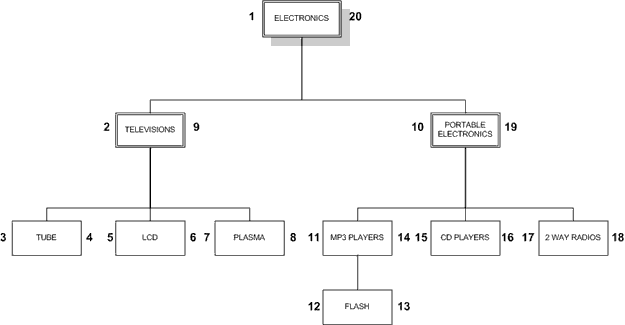
When working with a tree, we work from left to right,
one layer at a time, descending to each node's children
before assigning a right-hand number and moving on to
the right. This approach is called the modified preorder
tree traversal algorithm.
Retrieving a Full Tree
We can retrieve the full tree through the use of a
self-join that links parents with nodes on the basis
that a node's lft value will always appear between its
parent's lft and rgt values:
SELECT node.name
FROM nested_category AS node,
nested_category AS parent
WHERE node.lft BETWEEN parent.lft AND parent.rgt
AND parent.name = 'ELECTRONICS'
ORDER BY node.lft;

Unlike our previous examples with the adjacency list
model, this query will work regardless of the depth
of the tree. We do not concern ourselves with the rgt
value of the node in our BETWEEN clause because the
rgt value will always fall within the same parent as
the lft values.
Finding all the Leaf Nodes
Finding all leaf nodes in the nested set model even
simpler than the LEFT JOIN method used in the adjacency
list model. If you look at the nested_category table,
you may notice that the lft and rgt values for leaf
nodes are consecutive numbers. To find the leaf nodes,
we look for nodes where rgt = lft + 1:
SELECT name
FROM nested_category
WHERE rgt = lft + 1;

Retrieving a Single Path
With the nested set model, we can retrieve a single
path without having multiple self-joins:
SELECT parent.name
FROM nested_category AS node,
nested_category AS parent
WHERE node.lft BETWEEN parent.lft AND parent.rgt
AND node.name = 'FLASH'
ORDER BY parent.lft;

Finding the Depth of the Nodes
We have already looked at how to show the entire tree,
but what if we want to also show the depth of each node
in the tree, to better identify how each node fits in
the hierarchy? This can be done by adding a COUNT function
and a GROUP BY clause to our existing query for showing
the entire tree:
SELECT node.name, (COUNT(parent.name) - 1) AS depth
FROM nested_category AS node,
nested_category AS parent
WHERE node.lft BETWEEN parent.lft AND parent.rgt
GROUP BY node.name
ORDER BY node.lft;
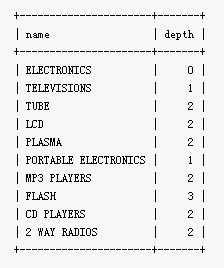
We can use the depth value to indent our category names
with the CONCAT and REPEAT string functions:
SELECT CONCAT( REPEAT(' ', COUNT(parent.name) - 1),
node.name) AS name
FROM nested_category AS node,
nested_category AS parent
WHERE node.lft BETWEEN parent.lft AND parent.rgt
GROUP BY node.name
ORDER BY node.lft;
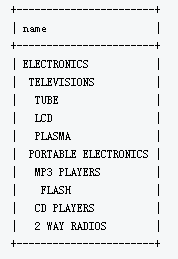
Of course, in a client-side application you will be
more likely to use the depth value directly to display
your hierarchy. Web developers could loop through the
tree, adding <li></li> and <ul></ul>
tags as the depth number increases and decreases.
Depth of a Sub-Tree
When we need depth information for a sub-tree, we cannot
limit either the node or parent tables in our self-join
because it will corrupt our results. Instead, we add
a third self-join, along with a sub-query to determine
the depth that will be the new starting point for our
sub-tree:
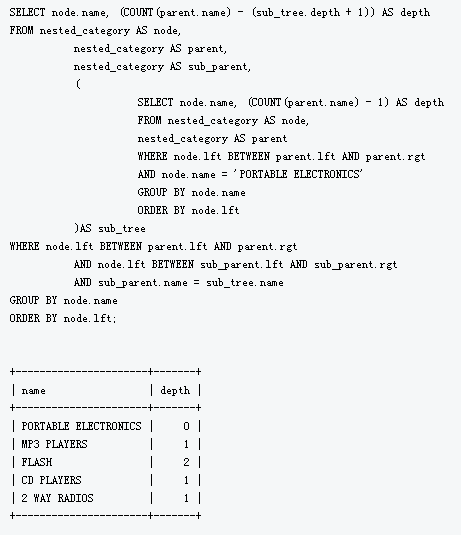
This function can be used with any node name, including
the root node. The depth values are always relative
to the named node.
Find the Immediate Subordinates of
a Node
Imagine you are showing a category of electronics products
on a retailer web site. When a user clicks on a category,
you would want to show the products of that category,
as well as list its immediate sub-categories, but not
the entire tree of categories beneath it. For this,
we need to show the node and its immediate sub-nodes,
but no further down the tree. For example, when showing
the PORTABLE ELECTRONICS category, we will want to show
MP3 PLAYERS, CD PLAYERS, and 2 WAY RADIOS, but not FLASH.
This can be easily accomplished by adding a HAVING
clause to our previous query:

If you do not wish to show the parent node, change
the HAVING depth <= 1 line to HAVING depth = 1.
Aggregate Functions in a Nested Set
Let's add a table of products that we can use to demonstrate
aggregate functions with:
CREATE TABLE product(
product_id INT AUTO_INCREMENT PRIMARY KEY,
name VARCHAR(40),
category_id INT NOT NULL
);
INSERT INTO product(name, category_id) VALUES('20"
TV',3),('36" TV',3),
('Super-LCD 42"',4),('Ultra-Plasma 62"',5),('Value
Plasma 38"',5),
('Power-MP3 5gb',7),('Super-Player 1gb',8),('Porta
CD',9),('CD To go!',9),
('Family Talk 360',10);
SELECT * FROM product;

Now let's produce a query that can retrieve our category
tree, along with a product count for each category:
SELECT parent.name, COUNT(product.name)
FROM nested_category AS node ,
nested_category AS parent,
product
WHERE node.lft BETWEEN parent.lft AND parent.rgt
AND node.category_id = product.category_id
GROUP BY parent.name
ORDER BY node.lft;
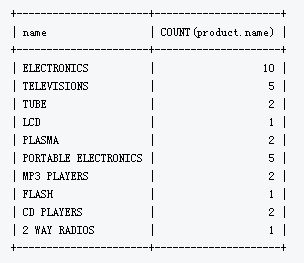
This is our typical whole tree query with a COUNT and
GROUP BY added, along with a reference to the product
table and a join between the node and product table
in the WHERE clause. As you can see, there is a count
for each category and the count of subcategories is
reflected in the parent categories.
Adding New Nodes
Now that we have learned how to query our tree, we
should take a look at how to update our tree by adding
a new node. Let's look at our nested set diagram again:

If we wanted to add a new node between the TELEVISIONS
and PORTABLE ELECTRONICS nodes, the new node would have
lft and rgt values of 10 and 11, and all nodes to its
right would have their lft and rgt values increased
by two. We would then add the new node with the appropriate
lft and rgt values. While this can be done with a stored
procedure in MySQL 5, I will assume for the moment that
most readers are using 4.1, as it is the latest stable
version, and I will isolate my queries with a LOCK TABLES
statement instead:
LOCK TABLE nested_category WRITE;
SELECT @myRight := rgt FROM nested_category
WHERE name = 'TELEVISIONS';
UPDATE nested_category SET rgt = rgt + 2 WHERE rgt
> @myRight;
UPDATE nested_category SET lft = lft + 2 WHERE lft
> @myRight;
INSERT INTO nested_category(name, lft, rgt) VALUES('GAME
CONSOLES', @myRight + 1, @myRight + 2);
UNLOCK TABLES;
We can then check our nesting with our indented tree
query:
SELECT CONCAT( REPEAT( ' ', (COUNT(parent.name) - 1)
), node.name) AS name
FROM nested_category AS node,
nested_category AS parent
WHERE node.lft BETWEEN parent.lft AND parent.rgt
GROUP BY node.name
ORDER BY node.lft;

If we instead want to add a node as a child of a node
that has no existing children, we need to modify our
procedure slightly. Let's add a new FRS node below the
2 WAY RADIOS node:
LOCK TABLE nested_category WRITE;
SELECT @myLeft := lft FROM nested_category
WHERE name = '2 WAY RADIOS';
UPDATE nested_category SET rgt = rgt + 2 WHERE rgt
> @myLeft;
UPDATE nested_category SET lft = lft + 2 WHERE lft
> @myLeft;
INSERT INTO nested_category(name, lft, rgt) VALUES('FRS',
@myLeft + 1, @myLeft + 2);
UNLOCK TABLES;
In this example we expand everything to the right of
the left-hand number of our proud new parent node, then
place the node to the right of the left-hand value.
As you can see, our new node is now properly nested:
SELECT CONCAT( REPEAT( ' ', (COUNT(parent.name) - 1)
), node.name) AS name
FROM nested_category AS node,
nested_category AS parent
WHERE node.lft BETWEEN parent.lft AND parent.rgt
GROUP BY node.name
ORDER BY node.lft;
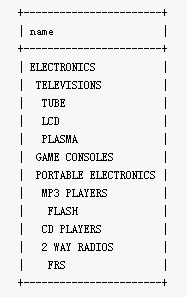
Deleting Nodes
The last basic task involved in working with nested
sets is the removal of nodes. The course of action you
take when deleting a node depends on the node's position
in the hierarchy; deleting leaf nodes is easier than
deleting nodes with children because we have to handle
the orphaned nodes.
When deleting a leaf node, the process if just the
opposite of adding a new node, we delete the node and
its width from every node to its right:
LOCK TABLE nested_category WRITE;
SELECT @myLeft := lft, @myRight := rgt, @myWidth :=
rgt - lft + 1
FROM nested_category
WHERE name = 'GAME CONSOLES';
DELETE FROM nested_category WHERE lft BETWEEN @myLeft
AND @myRight;
UPDATE nested_category SET rgt = rgt - @myWidth WHERE
rgt > @myRight;
UPDATE nested_category SET lft = lft - @myWidth WHERE
lft > @myRight;
UNLOCK TABLES;
And once again, we execute our indented tree query
to confirm that our node has been deleted without corrupting
the hierarchy:
SELECT CONCAT( REPEAT( ' ', (COUNT(parent.name) - 1)
), node.name) AS name
FROM nested_category AS node,
nested_category AS parent
WHERE node.lft BETWEEN parent.lft AND parent.rgt
GROUP BY node.name
ORDER BY node.lft;
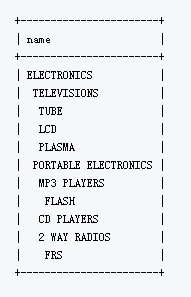
This approach works equally well to delete a node and
all its children:
LOCK TABLE nested_category WRITE;
SELECT @myLeft := lft, @myRight := rgt, @myWidth :=
rgt - lft + 1
FROM nested_category
WHERE name = 'MP3 PLAYERS';
DELETE FROM nested_category WHERE lft BETWEEN @myLeft
AND @myRight;
UPDATE nested_category SET rgt = rgt - @myWidth WHERE
rgt > @myRight;
UPDATE nested_category SET lft = lft - @myWidth WHERE
lft > @myRight;
UNLOCK TABLES;
And once again, we query to see that we have successfully
deleted an entire sub-tree:
SELECT CONCAT( REPEAT( ' ', (COUNT(parent.name) - 1)
), node.name) AS name
FROM nested_category AS node,
nested_category AS parent
WHERE node.lft BETWEEN parent.lft AND parent.rgt
GROUP BY node.name
ORDER BY node.lft;
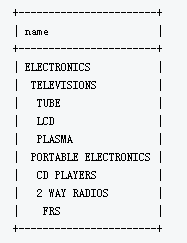
The other scenario we have to deal with is the deletion
of a parent node but not the children. In some cases
you may wish to just change the name to a placeholder
until a replacement is presented, such as when a supervisor
is fired. In other cases, the child nodes should all
be moved up to the level of the deleted parent:
LOCK TABLE nested_category WRITE;
SELECT @myLeft := lft, @myRight := rgt, @myWidth :=
rgt - lft + 1
FROM nested_category
WHERE name = 'PORTABLE ELECTRONICS';
DELETE FROM nested_category WHERE lft = @myLeft;
UPDATE nested_category SET rgt = rgt - 1, lft = lft
- 1 WHERE lft BETWEEN @myLeft AND @myRight;
UPDATE nested_category SET rgt = rgt - 2 WHERE rgt
> @myRight;
UPDATE nested_category SET lft = lft - 2 WHERE lft
> @myRight;
UNLOCK TABLES;
In this case we subtract two from all elements to the
right of the node (since without children it would have
a width of two), and one from the nodes that are its
children (to close the gap created by the loss of the
parent's left value). Once again, we can confirm our
elements have been promoted:
SELECT CONCAT( REPEAT( ' ', (COUNT(parent.name) - 1)
), node.name) AS name
FROM nested_category AS node,
nested_category AS parent
WHERE node.lft BETWEEN parent.lft AND parent.rgt
GROUP BY node.name
ORDER BY node.lft;

Other scenarios when deleting nodes would include promoting
one of the children to the parent position and moving
the child nodes under a sibling of the parent node,
but for the sake of space these scenarios will not be
covered in this article.
Final Thoughts
While I hope the information within this article will
be of use to you, the concept of nested sets in SQL
has been around for over a decade, and there is a lot
of additional information available in books and on
the Internet. In my opinion the most comprehensive source
of information on managing hierarchical information
is a book called Joe Celko's Trees and Hierarchies in
SQL for Smarties, written by a very respected author
in the field of advanced SQL, Joe Celko. Joe Celko is
often credited with the nested sets model and is by
far the most prolific author on the subject. I have
found Celko's book to be an invaluable resource in my
own studies and highly recommend it. The book covers
advanced topics which I have not covered in this article,
and provides additional methods for managing hierarchical
data in addition to the Adjacency List and Nested Set
models.
In the References / Resources section that follows
I have listed some web resources that may be of use
in your research of managing hierarchal data, including
a pair of PHP related resources that include pre-built
PHP libraries for handling nested sets in MySQL. Those
of you who currently use the adjacency list model and
would like to experiment with the nested set model will
find sample code for converting between the two in the
Storing Hierarchical Data in a Database resource listed
below.
|


